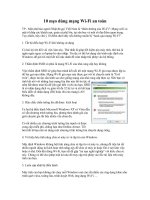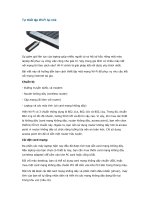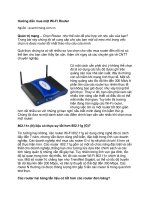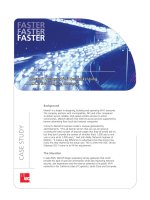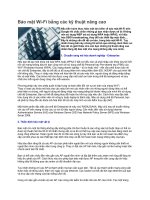ESP8266 robotics projects DIY wi fi controlled robots ( TQL )
Bạn đang xem bản rút gọn của tài liệu. Xem và tải ngay bản đầy đủ của tài liệu tại đây (23.65 MB, 201 trang )
ESP8266 Robotics Projects
DIY Wi-Fi controlled robots
Pradeeka Seneviratne
BIRMINGHAM - MUMBAI
ESP8266 Robotics Projects
Copyright © 2017 Packt Publishing
All rights reserved. No part of this book may be reproduced, stored in a retrieval system, or
transmitted in any form or by any means, without the prior written permission of the
publisher, except in the case of brief quotations embedded in critical articles or reviews.
Every effort has been made in the preparation of this book to ensure the accuracy of the
information presented. However, the information contained in this book is sold without
warranty, either express or implied. Neither the author, nor Packt Publishing, and its
dealers and distributors will be held liable for any damages caused or alleged to be caused
directly or indirectly by this book.
Packt Publishing has endeavored to provide trademark information about all of the
companies and products mentioned in this book by the appropriate use of capitals.
However, Packt Publishing cannot guarantee the accuracy of this information.
First published: November 2017
Production reference: 1281117
Published by Packt Publishing Ltd.
Livery Place
35 Livery Street
Birmingham
B3 2PB, UK.
ISBN 978-1-78847-461-0
www.packtpub.com
Credits
Author
Pradeeka Seneviratne
Copy Editors
Safis Editing
Ulka Manjrekar
Reviewer
Shweta Gupte
Project Coordinator
Kinjal Bari
Commissioning Editor
Gebin George
Proofreader
Safis Editing
Acquisition Editor
Prachi Bisht
Indexer
Pratik Shirodkar
Content Development Editor
Trusha Shriyan
Graphics
Kirk D'Penha
Technical Editor
Sayali Thanekar
Production Coordinator
Nilesh Mohite
About the Author
Pradeeka Seneviratne is a software engineer with over 10 years of experience in computer
programming and systems design. He is an expert in the development of Arduino and
Raspberry Pi-based embedded systems. Pradeeka is currently a full-time embedded
software engineer who works with embedded systems and highly scalable technologies.
Previously, he worked as a software engineer for several IT infrastructure and technology
servicing companies. He collaborated with the Outernet project as a volunteer hardware
and software tester for Lighthouse and Raspberry Pi-based DIY Outernet receivers based on
Ku band satellite frequencies. He is also the author of five books:
Internet of Things with Arduino Blueprints [Packt Publishing]
IoT: Building Arduino-Based Projects [Packt Publishing]
Building Arduino PLCs [Apress]
Raspberry Pi 3 Projects for Java Programmers [Packt Publishing]
Beginning BBC micro:bit [Apress]
About the Reviewer
Shweta Gupte is an embedded systems engineer with 4 years, experience in the robotics
field. Shweta has worked with robots both at the software level and with a low-level
hardware interface. She has experience of working with embedded system design, RTOS,
microcontroller programming, and the low-level interfacing of robots, motion planning,
and computer vision.
Shweta has experience in programming in C, Embedded C, JAVA, MATLAB, and
microcontroller assembly language. She has worked with low-level controllers, including
Renesas RX62, Renesas QSK, Arduino, PIC, and Rasberry Pi.
Currently, she is working at Mathworks to develop MATLAB and Simulink products for
robotics and embedded targets, including developing automated test beds and hardware
testing. She has a masters degree in electrical engineering and a bachelors degree in
electronics and telecommunications.
Her interests include playing with low-cost microcontroller-based robots and quadrotors.
She likes to spend her spare time rock climbing and fostering rescued dogs.
www.PacktPub.com
For support files and downloads related to your book, please visit www.PacktPub.com.
Did you know that Packt offers eBook versions of every book published, with PDF and
ePub files available? You can upgrade to the eBook version at www.PacktPub.com and as a
print book customer, you are entitled to a discount on the eBook copy. Get in touch with us
at for more details.
At www.PacktPub.com, you can also read a collection of free technical articles, sign up for a
range of free newsletters and receive exclusive discounts and offers on Packt books and
eBooks.
https://www.packtpub.com/mapt
Get the most in-demand software skills with Mapt. Mapt gives you full access to all Packt
books and video courses, as well as industry-leading tools to help you plan your personal
development and advance your career.
Why subscribe?
Fully searchable across every book published by Packt
Copy and paste, print, and bookmark content
On demand and accessible via a web browser
Customer Feedback
Thanks for purchasing this Packt book. At Packt, quality is at the heart of our editorial
process. To help us improve, please leave us an honest review on this book's Amazon page
at http://www.amazon.com/dp/1788474619.
If you'd like to join our team of regular reviewers, you can email us at
We award our regular reviewers with free eBooks and
videos in exchange for their valuable feedback. Help us be relentless in improving our
products!
Table of Contents
Preface
Chapter 1: Getting Ready
ESP8266EX
ESP-01
Board features and connections
Connections
Connecting with a breadboard
Power supply
Connecting through USB for flashing
Using a serial terminal program
AT commands
Using AT commands
Using the Arduino IDE
Installing the Arduino core for an ESP8266 Wi-Fi chip
Hello world
Listing 1-1 – Blink a LED
Using chassis kits and accessories to build robots
Mini 3-Layer Round Robot Chassis Kit
Zumo chassis kit
Romi chassis kit
Mini robot rover chassis kit
Rover 5 robot platform
Wheel encoder kit
Parallel Gripper Kit A - Channel mount
Summary
1
6
7
8
9
10
11
11
12
14
16
19
20
20
23
24
24
24
25
26
27
28
29
29
30
Chapter 2: Building a Mini Round Robot with Original ESP8266
31
Things you will need
Assembling the Mini 3-Layer Round Robot chassis kit
Assembling the wheels
Assembling the chassis
Attaching 9V battery box to the chassis layer
Connecting the middle chassis
Attaching 4 x AA battery box to the chassis layer
Mounting the Arduino board
32
32
33
36
38
39
40
41
Table of Contents
Wiring them together
Connecting the Arduino with motor driver
Connecting the motors with the motor driver
Connecting the ESP01 with Arduino
Writing sketches
Using Blynk
Installing the Blynk library for Arduino
Writing the Arduino sketch
Working with the Blynk Sketch Code Builder
Listing 2-1 – Example code generated with the Blynk Sketch Code Builder
Listing 2-2 – complete sketch for mini round robot
Uploading the sketch
Applying power
Playing the robot
Summary
Chapter 3: Using Encoders
41
41
42
42
44
44
52
54
54
58
64
67
67
68
69
70
Things you will need
The Wheel Encoder Kit
Connecting the encoders with motors
Wiring the encoders with Arduino
Reading encoders
Creating a Blynk app
Writing an Arduino sketch
Listing 3-1 – Displaying average of the pulses generated by the two wheel encoders
(the hall-effect sensors)
Calculating the distance traveled
Calculating the average speed
Listing 3-3 – Calculating and displaying the average speed
Playing the 3-Layer Mini Round Robot
Summary
Chapter 4: Building a Mini Round Robot with the Feather HUZZAH
ESP8266
Things you will need
What is Feather HUZZAH ESP8266?
The DC Motor + Stepper FeatherWing
Downloading the Adafruit Motor Shield V2 library
Assembling the robot
Creating a Blynk app
Writing the Arduino UNO sketch
[ ii ]
70
71
72
73
75
75
83
84
89
91
92
92
93
94
95
96
97
97
98
101
104
Table of Contents
Listing 4-1 – Arduino sketch for controlling the Mini Round Robot
Testing the robot
Summary
Chapter 5: Line-Following Zumo Robot
Things you will need
Assembling the Zumo chassis Kit
Attaching the Feather Doubler
Building a line-following course
Writing Arduino sketch
Listing 5-1 – Arduino sketch for line-following
Uploading the sketch
Playing with your robot
Summary
Chapter 6: Building an ESP8266 Robot Controller
Things you will need
Building the Romi Robot
Ball casters
Battery contacts
Motors
Wheels
The battery compartment and power distribution
Attaching the FeatherWing Doubler
Building the Robot Controller
Software
Arduino sketch for the Robot Controller
Coding the Romi Robot
Listing 6-2 – Arduino sketch for the Robot
Play it
Summary
Chapter 7: Building a Gripper Robot
Things you will need
Mini Robot Rover chassis kit
Assembling the chassis
Assembling the Gripper Kit
Connecting the gripper to the chassis
Assembling electronics
Controlling the gripper with Blynk
Creating the Blynk app
[ iii ]
106
113
114
115
115
116
118
123
123
124
130
130
131
132
133
133
136
137
139
141
143
143
147
149
149
151
151
155
156
157
157
158
159
159
166
167
169
169
Table of Contents
Software
Testing the gripper
Summary
169
171
171
Chapter 8: Photo Rover Robot
172
Things you will need
Rover 5 chassis
Connecting the electronics
Wiring the ArduCAM with the Feather HUZZAH ESP8266
Software
Arduino libraries
Summary
Index
172
173
175
179
181
181
186
187
[ iv ]
Preface
This book is all about robotics projects based on the original ESP8266 microcontroller board
and some variants of ESP8266 boards. The ESP8266 Wi-Fi module is a self-contained SOC
with an integrated TCP/IP protocol stack that can give any microcontroller access to your
Wi-Fi network. It has powerful processing and storage capabilities. It also supports
application hosting and Wi-Fi networking.
The first chapter explains everything that you need to build your development environment
with basic hardware and software components. This book uses an original ESP8266 board
and an AdafruitFeather HUZZAH ESP8266 board for all the robotic projects. You will also
learn how to use different types of chassis kits, motors, motor drivers, power supplies and
distribution boards, sensors, and actuators to build robotic projects that can be controlled
via Wi-Fi. You will also use line sensors, ArduCam, wheel encoders, and a Gripper Kit to
build more specialized robots.
What this book covers
Chapter 1, Getting Ready, introduces the original ESP8266, that is, ESP-01, sets up a
development environment with the hardware and software needed to write code for
ESP8266, and explains how to use the Arduino Core to write code for ESP8266 boards with
the Arduino IDE. This chapter will also present how to use the AT command with PuTTY to
execute on an ESP8266.
Chapter 2, Building a Mini Round Robot with Original ESP8266, explains how to build a Mini
Round Robot using the Mini 3-Layer Round Robot Chassis Kit with the ESP-01 board,
Arduino, and some electronics. This chapter will also explain how to develop a Blynk app
to control the robot through a Wi-Fi network.
Chapter 3, Using Encoders, shows how to modify the Mini 3-Layer Round Robot you built
in the previous chapter by integrating a wheel encoder kit to calculate average speed and
distance traveled based on the pulses generated by the hall-effect sensors. This chapter will
also explain how to modify the Blynk app you built in the previous chapter to show the
calculated average speed and distance traveled.
Chapter 4, Building a Mini Round Robot with the Feather HUZZAH ESP8266, shows how to
replace the original ESP8266 board with a physically smaller and more lightweight Feather
HUZZAH ESP8266 board. The chapter will also explain how to develop a Blynk app to
control the robot through a Wi-Fi network.
Preface
Chapter 5, Line-Following Zumo Robot, teaches how to build a robot that follows a line,
either a black line on a white surface or a white line on a black surface, by integrating a Line
Follower Array. The chapter will also explain how to build a line following course.
Chapter 6, Building an ESP8266 Robot Controller, shows how to build an ESP8266-based
simple Robot Controller that can be used to control a Romi Robot through a Wi-Fi network
using Blynk Bridge.
Chapter 7, Building a Gripper Robot, explains how to build a robot based on the Mini Robot
Rover chassis, a parallel Gripper Kit, and a servo motor. The chapter will also explain how
to build a Blynk app to control the gripper through a Wi-Fi network.
Chapter 8, Photo Rover Robot, shows how to build a rover robot that can be used to take
pictures with an ArduCAM from remote locations and view them using a web browser. The
robot uses a web socket server that allows you to control the camera using a simple webbased interface. The same interface can be used to view the captured image as well.
What you need for this book
To get the most from this book, you need a basic knowledge of programming with the
Arduino IDE and electronics.
Who this book is for
This book is for those who are familiar with robotics and want to build robotics projects
using the ESP8266 microcontroller.
Conventions
In this book, you will find a number of text styles that distinguish between different kinds
of information. Here are some examples of these styles and an explanation of their meaning.
Code words in text, database table names, folder names, filenames, file extensions,
pathnames, dummy URLs, user input, and Twitter handles are shown as follows: "Copy all
these tools to your_sketchbook_folder/tools of the Arduino IDE."
[2]
Preface
A block of code is set as follows:
#include BLYNK_WRITE(V1)
{
intx = param[0].asInt(); // assigning incoming value from pin V1 to a
variable
inty = param[1].asInt(); // assigning incoming value from pin V1 to a
variable
New terms and important words are shown in bold. Words that you see on the screen, for
example, in menus or dialog boxes, appear in the text like this: "Run the mini round robot
project in the Blynk app by tapping on the Play button."
Warnings or important notes appear like this.
Tips and tricks appear like this.
Reader feedback
Feedback from our readers is always welcome. Let us know what you think about this
book—what you liked or disliked. Reader feedback is important for us as it helps us
develop titles that you will really get the most out of.
To send us general feedback, simply email , and mention the
book's title in the subject of your message.
If there is a topic that you have expertise in and you are interested in either writing or
contributing to a book, see our author guide at www.packtpub.com/authors.
Customer support
Now that you are the proud owner of a Packt book, we have a number of things to help you
to get the most from your purchase.
[3]
Preface
Downloading the example code
You can download the example code files for this book from your account at http://www.
packtpub.com. If you purchased this book elsewhere, you can visit http://www.packtpub.
com/support and register to have the files emailed directly to you.
You can download the code files by following these steps:
1.
2.
3.
4.
5.
6.
7.
Log in or register on our website using your email address and password.
Hover the mouse pointer on the SUPPORT tab at the top.
Click on Code Downloads & Errata.
Enter the name of the book in the Search box.
Select the book for which you're looking to download the code files.
Choose from the drop-down menu where you purchased this book from.
Click on Code Download.
Once the file is downloaded, please make sure that you unzip or extract the folder using the
latest version of:
WinRAR / 7-Zip for Windows
Zipeg / iZip / UnRarX for Mac
7-Zip / PeaZip for Linux
The code bundle for the book is also hosted on GitHub at https://github.com/
PacktPublishing/ESP8266-Robotics-Projects. We also have other code bundles from our
rich catalog of books and videos available at https://github.com/PacktPublishing/.
Check them out!
Downloading the color images of this book
We also provide you with a PDF file that has color images of the screenshots/diagrams used
in this book. The color images will help you better understand the changes in the output.
You can download this file from https://www.packtpub.com/sites/default/files/
downloads/ESP8266RoboticsProjects_ColorImages.pdf.
[4]
Preface
Errata
Although we have taken every care to ensure the accuracy of our content, mistakes do
happen. If you find a mistake in one of our books-maybe a mistake in the text or the codewe would be grateful if you could report this to us. By doing so, you can save other readers
from frustration and help us improve subsequent versions of this book. If you find any
errata, please report them by visiting http://www.packtpub.com/submit-errata, selecting
your book, clicking on the Errata Submission Form link, and entering the details of your
errata. Once your errata are verified, your submission will be accepted and the errata will
be uploaded to our website or added to any list of existing errata under the Errata section of
that title. To view the previously submitted errata, go to https://www.packtpub.com/
books/content/support and enter the name of the book in the search field. The required
information will appear under the Errata section.
Piracy
Piracy of copyrighted material on the internet is an ongoing problem across all media. At
Packt, we take the protection of our copyright and licenses very seriously. If you come
across any illegal copies of our works in any form on the internet, please provide us with
the location address or website name immediately so that we can pursue a remedy.
Please contact us at with a link to the suspected pirated
material.
We appreciate your help in protecting our authors and our ability to bring you valuable
content.
Questions
If you have a problem with any aspect of this book, you can contact us at
, and we will do our best to address the problem.
[5]
1
Getting Ready
Welcome to the exciting world of programming ESP8266 with Arduino core for ESP8266.
This chapter introduces ESP8266 and a simple LED blink program using the Arduino core
for the ESP8266 library.
In this chapter, you will learn the following topics:
The basics of ESP8266 and the module family
The original ESP8266 ESP-01
Applying regulated power to ESP-01
Connecting ESP-01 with computer through a USB to TTL serial console cable
Preparing the development environment by installing the Arduino core for the
ESP8266 library
Writing a simple LED blink program using the Arduino core for ESP8266
Using AT commands
The overview of some robotics hardware and accessories
Getting Ready
Chapter 1
ESP8266EX
The ESP8266EX (Figure 1.1) is a single-chip microcontroller developed by Espressif
( It can be used to develop low-power, highly-integrated Wi-Fi
solutions especially for mobile devices, wearable electronics, and the Internet of Things
(IoT) applications. The main advantage of ESP8266EX is that it can give any microcontroller
access to a Wi-Fi network. As an example, it can offload all Wi-Fi networking functions for
Arduino just like the Arduino Wi-Fi shield:
Figure 1.1: ESP8266EX chip
The chip has the following great features:
Small size (5 mm x 5 mm)
Requires minimal external circuitry
Wide temperature range (-40°C to + 125°C)
All-in-one small package -SoC (integrates a 32-bit Tensilica MCU, standard
digital peripheral interfaces, antenna switches, RF balun, power amplifier, lownoise receive amplifier, filters, and power management modules)
Low power consumption
[7]
Getting Ready
Chapter 1
ESP-01
ESP-01 is a small Wi-Fi module based on Espressif ESP8266EX that can give any
microcontroller access to a Wi-Fi network. The ESP-01 module (Figure 1.2) is the basic and
the most popular board of the ESP8266 module family. You should have an ESP8266 ESP-01
module to understand the basics of ESP8266 and build robotics projects.
This is a list of vendors that typically stock the ESP-01 modules:
SparkFun Electronics: />Adafruit Industries: />Electrodragon: />
Figure 1.2: The original ESP8266 ESP-01. Image courtesy of SparkFun Electronics ()
The original ESP8266 ESP-01 has the following features:
Offloads all Wi-Fi networking functions from another application's processor
Self-hosting of applications
Only four pins interface, VCC-3V3, GND, TX, and RX
1 MB (8 MB) flash memory
Pre-programmed AT command set firmware
Supports APSD for VoIP applications and Bluetooth co-existence interfaces
[8]
Getting Ready
Chapter 1
Here is a list of all the ESP8266 boards of the ESP8266 module family at the time of writing:
ESP-01
ESP-02
ESP-03
ESP-04
ESP-05
ESP-06
ESP-07
ESP-08
ESP-09
ESP-10
ESP-11
ESP-12
ESP-12F
ESP-12-E/Q
ESP-12S
ESP-13
ESP-14
Board features and connections
The top of the ESP-01 board consist of the following things:
An ESP8266EX chip—Offloading all Wi-Fi networking functions
A Berg Micro BG25Q80A 1518 flash chip—Serial Peripheral Interface (SPI) flash
memory
A printed Wi-Fi antenna—Transmitting and receiving Wi-Fi signals
[9]
Getting Ready
Chapter 1
Figure 1.3: ESP-01 top view
Connections
The original ESP8266 ESP-01 board has eight pins and comes without headers. You can
solder regular wires with pins, but if you want to use it with a breadboard, you should
attach headers:
Figure 1.4: ESP-01 pinout
[ 10 ]
Getting Ready
Chapter 1
GPIO0: Connects to pin 3 of the ESP8266
GPIO2: Connects to pin 5 of the ESP8266
TX: This is the transmitting line that connects to RX of another device
RX: This is the receiving line that connects to TX of another device
3V: This accepts regulated 3.3V DC from a regulator to power the board
GND: The ground pin
CH_PD: Chip select
RST: The reset pin
Connecting with a breadboard
You can use one of the following things to connect ESP8266 with a breadboard:
Using female/male extension jumper wires (https://www.adafruit.com/
product/1954)
Using a 10-pin IDC breakout helper (https://www.adafruit.com/product/2102)
Power supply
The ESP8266 works only with regulated 3.3V. You can build a simple regulated power
supply with an LD1117-3.3 linear voltage regulator. It can provide 3.3V at 800 mA. You can
purchase a TO-220 package of the LD1117-3.3 for use with a breadboard. Figure 1.5 shows
the circuit diagram for 3.3V output. You can supply 4-15V DC to Vin using one of the
following sources:
7V LiPo battery
5V power bank
9V battery
5V "wall wart" power supply
[ 11 ]
Getting Ready
Chapter 1
Figure 1.5: 3.3V regulated power supply circuit diagram
Now, you can connect the power supply to ESP-01:
1. Connect VOUT to the Vcc pin of ESP-01.
2. Connect GND to the GND pin of ESP-01.
Connecting through USB for flashing
ESP8266 ESP-01 doesn't have a built-in USB to serial conversion chip to directly connect to
your computer through a USB cable for flashing programs. As a solution, you can use a USB
to TTL serial console cable to connect ESP8266 to a computer. Figure 1.6 shows a USB TTL
serial console cable from Adafruit ( />
Figure 1.6: A USB to TTL serial console cable. Image courtesy of Adafruit Industries ()
[ 12 ]
Getting Ready
Chapter 1
The type A USB plug includes a USB to serial conversion chip and provides four wires to
connect to your ESP8266ESP-01 board. Table 1.1 shows the functions of the four wires:
Color Function
Red
Power
Black Ground
White RX
Green TX
Table 1.1: Color codes and functions of wires
You can use the following steps to connect the USB to TTL serial cable with your ESP8266:
1.
2.
3.
4.
Connect the white RX wire of the cable to the TX pin of ESP8266
Connect the green TX wire of the cable to the RX pin of ESP8266
Connect the black ground wire of the cable to the GND pin of ESP8266
Connect the CH_PD pin of ESP8266 to the Vcc wire of the power supply
Don't connect the red power wire because it is 5V.
[ 13 ]
